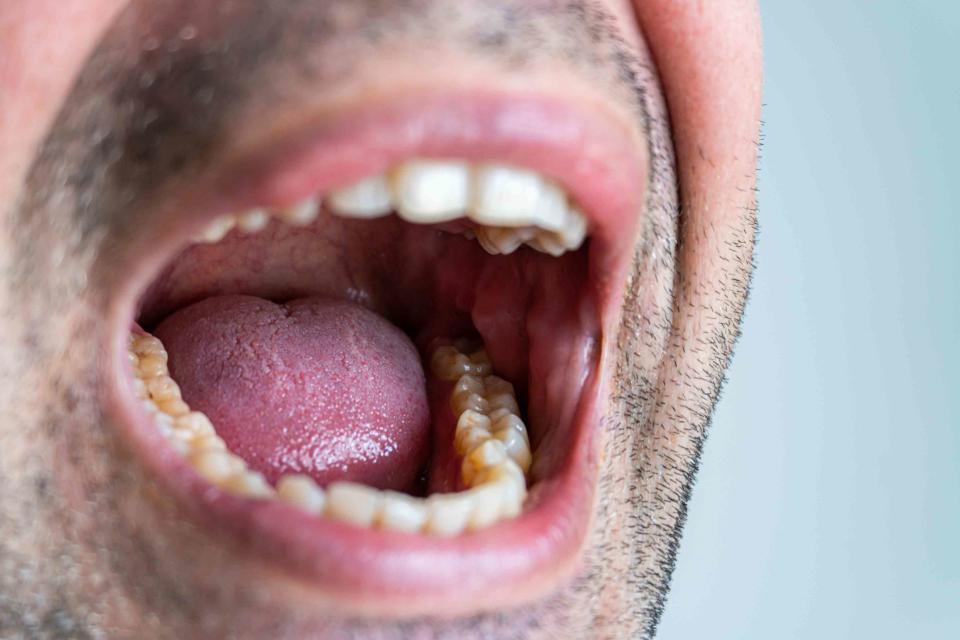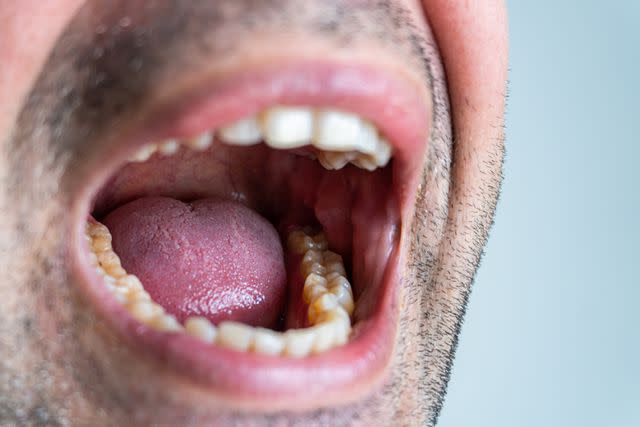8 Causes of a Bump on the Roof of the Mouth
And How to Treat It

Miguel Angel Flores / Getty Images
Medically reviewed by Edmund Khoo, DDS
A bump on the roof of the mouth may be a small blister, cyst, or hard lump you can feel with your tongue or finger. It may be painless or sore. A bump on the roof of the mouth may be due to various reasons, such as mouth sores, a bony growth, or lumps that develop from certain infections.
Most of the time, a bump on the roof of the mouth is harmless and will go away on its own, with or without treatment. A bump on the roof of the mouth that worsens or doesn’t go away after a few weeks may be a sign of a more serious condition, such as oral cancer, though that is rare.
This article talks about symptoms that may accompany a bump on the roof of the mouth, potential causes, and signs that a bump on the roof of the mouth should be looked at by a healthcare provider.

Miguel Angel Flores / Getty Images
Causes
There is a variety of conditions that cause a bump on the roof of the mouth, such as a canker sore, burn, or cyst. Most of the time, the causes of a bump on the roof of the mouth are harmless and nothing to be worried about. More serious causes may lead to a bump that doesn’t go away on its own and should be assessed by a healthcare provider.
Below are some common causes as well as associated symptoms to help distinguish what may be leading to a bump on the roof of the mouth.
Torus Palatinus
Torus palatinus is a bony growth on the roof of the mouth. Some people are born with it, while others may develop it later in life. Torus palatinus is usually painless but large growths may cause complications such as discomfort and difficulty eating, swallowing, or chewing.
Canker Sore
Canker sores are small sores that appear on the mouth's inside, including the mouth's roof. They appear as round, whitish, or yellowish sores with a red ring around them. They can show up as one or in small clusters. A canker sore may be painful, with the first three to four days being the worst; it usually goes away on its own.
Cold Sore
A cold sore often appears on the lips but can also appear on the roof of the mouth. Cold sores result from oral herpes, caused by the herpes simplex virus, specifically herpes simplex 1 (HSV-1). Cold sores are contagious. You will often feel tingling, burning, or tenderness before the cold sore appears. It will look like a blister and may crust over before going away.
Injury
Injuries to the tissue on the roof of the mouth may lead to swelling or a blister that feels like a bump. It may also be accompanied by bleeding or pain. These injuries usually heal on their own.
Epstein Pearls
Epstein pearls are whitish-yellow cysts on the gums or the roof of the mouth and are common among newborn babies. They can look like teeth coming in. Epstein pearls usually go away within a few weeks after birth.
Squamous Papilloma
Squamous papilloma are harmless, painless growths associated with human papilloma virus (HPV). They are commonly found on the tongue or roof of the mouth. Squamous papilloma are noncancerous and do not require treatment, though they can be removed surgically.
Infection
Some types of infection may lead to a bump on the roof of the mouth, including candidiasis and hand, foot, and mouth disease. Candidiasis, also known as oral thrush, is a fungal infection caused by a type of yeast from the genus Candida. Candidiasis often appears as white patches on the roof of the mouth, inner cheeks, tongue, and throat. These patches may be sore and cause pain while eating or swallowing.
Hand, foot, and mouth disease most often affect young children but older children and adults can also get it. One of the symptoms of hand, foot, and mouth disease is mouth sores that may blister and become painful.
Oral Cancer
Cancer on the roof of the mouth is called hard palate cancer. Hard palate cancer includes squamous cell carcinoma and salivary gland cancer. Oral cancer is rare, but factors like smoking or alcohol use may increase risk.
Diagnosis
Diagnosing a bump on the roof of the mouth may involve a physical exam of the mouth. While a healthcare provider should only make a diagnosis, most of the time, a bump on the roof of the mouth will go away on its own and does not require medical attention. A proper diagnosis is essential for getting the right treatment if desired.
A bump on the roof of the mouth that doesn’t go away on its own or worsens should be looked at by a healthcare provider. A healthcare provider may ask about other symptoms and run some tests to see the underlying cause.
Treatment
Treatment for a bump on the roof of the mouth will depend on the cause. A bump on the roof of the mouth usually disappears by itself. However, you may seek treatment options to help speed up the healing process.
For example, a healthcare provider may recommend an over-the-counter (OTC) pain reliever medication to manage bothersome canker sores. More serious causes, like an infection, may require more follow-up care. Be sure to talk with a healthcare provider if the bump doesn’t go away or gets worse so that you can get a diagnosis and treatment started right away.
Prognosis
Most of the time, a bump on the roof of the mouth is nothing to worry about and will usually go away without treatment. A bump on the roof of the mouth that doesn’t go away on its own may require medical attention.
Talk to a healthcare provider if you have a bump on the roof of the mouth that doesn’t go away after a few weeks or changes in size or appearance. In addition, if the bump causes any of the following, speak with a healthcare provider:
Pain from the bump that doesn't go away
Difficulty chewing or swallowing
Consistent bleeding
Summary
A bump on the roof of the mouth has a variety of causes that are temporary or harmless. It will often go away on its own. A bump that lingers, changes in size or appearance, or is accompanied by other symptoms like bleeding should be looked at by a healthcare provider.

